It all began in 1974, with a matchbox. Sounds like the start of a cheesy film noir, right?
The Brazilian raintree’s history in the USA had its start with a matchbox (a match box is a container, about two inches by one and a half inches and about a half inch deep, made of cardboard, with a bit of sandpaper on the side to strike a match on. A match is an analog version of a lighter, usually a piece of wood with a mixture of sulphur and other magical chemicals that, when friction is applied to it, as from the sandpaper on the side of the box, will burst into flame. Kinda like magic. A matchbox is not a very large container) filled with some seeds from the sister-in-law of a gentleman named Jim Moody, that were….umm, smuggled into the USA. Smuggled might be too harsh, she was a nurse with the American embassy so there were certain privileges. The accounts vary but the seed count was 6-8 and Jim managed to propagate five of them. Of those five, one was given to Jim Smith, and that tree is at the Heathcote Exhibit, one was given to Helen Souder, one might have been given to Joe Samuels. Theres a thornless variety and one is lost to history. But all of the recipients were American Bonsai pioneers who worked directly with John Naka and should be remembered and revered. There’s not much respect for the past in today’s bonsai world sometimes.
Jim Moody kept the one he liked best, one where the trunk flattened out and became all muscly (which is a word it seems. Muscled is too, even though when you stare at them both too long they look weird). It also has darker green leaves and shorter internodes. The better of the seedlings, I should add. Except it is very hesitant to bloom.
The one I have today is from one of the other seeds. It was an airlayer off a tree, brought to the Ft Myers area many years ago, planted in the ground and allowed to be a real tree (I’m a real boy!!!) 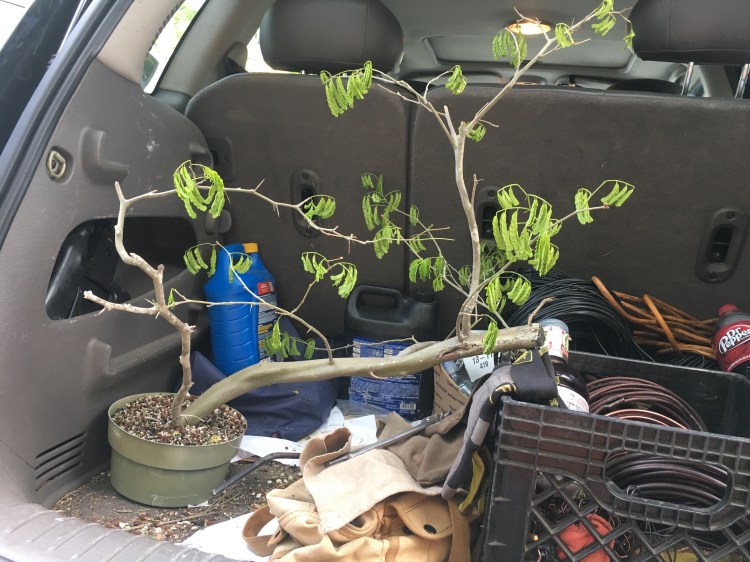 Notice the lighter green color and how large the leaves are with extra spaces between the clusters of leaflets?
Notice the lighter green color and how large the leaves are with extra spaces between the clusters of leaflets? 
….and the flowers 

The airlayer was given to me by Martha Goff (author of the books Tropical Green Sheets 1 and 2, two indispensable books available on tropicalgreenbonsai.com)

It’s planted in her mix as well.
 The trunk is a little muscled, and will get more so as time goes on, but not as much as the Moody Variety.
The trunk is a little muscled, and will get more so as time goes on, but not as much as the Moody Variety.
The thorns are larger and the internodes further apart.

This bud is a combo flower/leaf bud, which explains the size.

The trunk shape is very interesting to me, a challenge. Let’s see if I can do something with it.
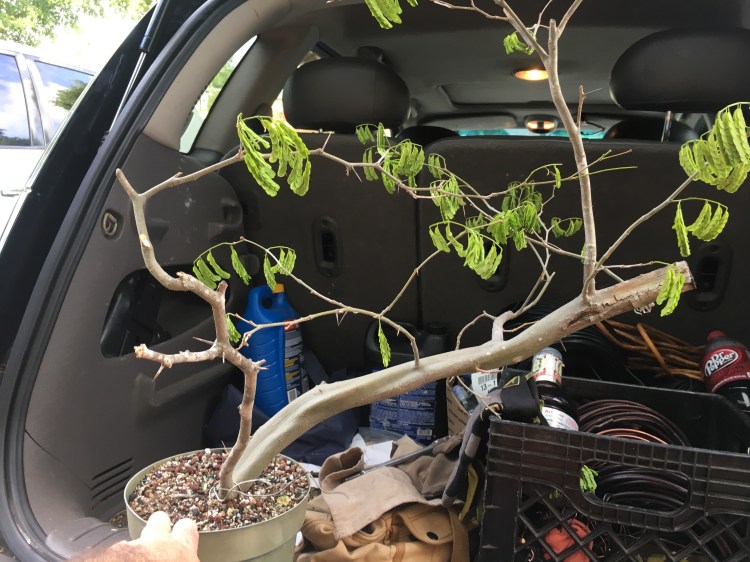
First step is defoliation and cutting the thorns off.
It’s (believe it or not) just a little controversial to remove the thorns. First, it doesn’t hurt or slow the growth to do it. The reason I do it is two fold. One: safety. It’s the same old joke about pricking your finger. Second, I don’t think they are in scale to create a good looking tree. Too big to be believable.
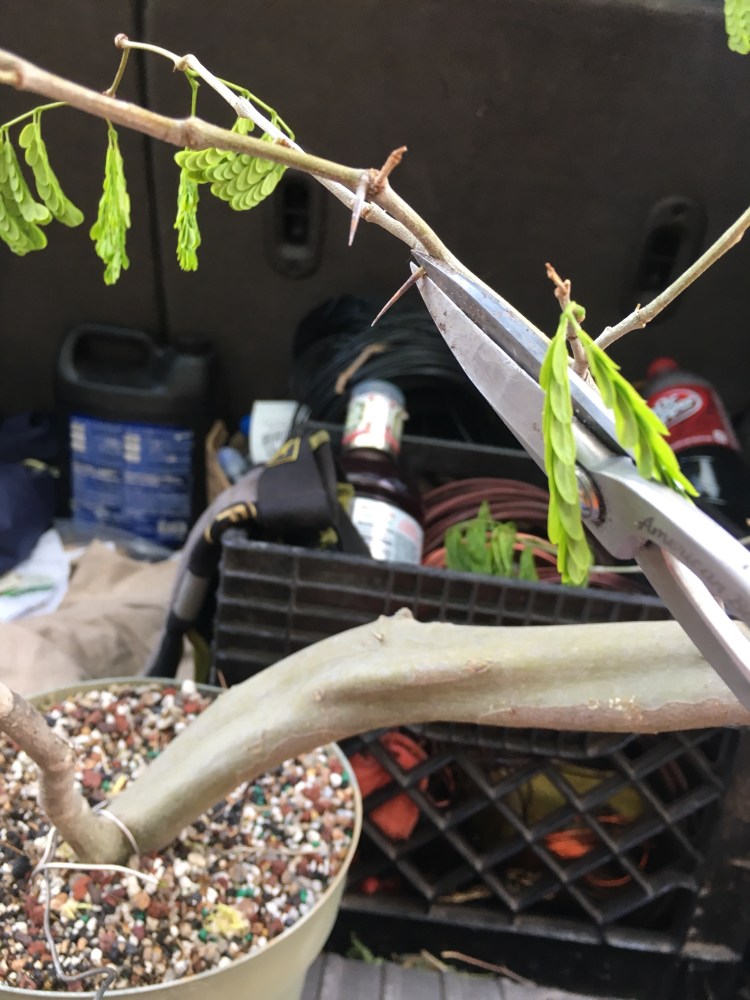 They call them raintrees because the leaves fold up when it’s going to rain. This is called “nyctinasty”. Charles Darwin was very interested in plant movement and wrote a book in 1880 called, unsurprisingly, ” The Power of Movement in Plants”. Why they (and many trees in the legume family) do this can only be guessed at, but the mechanism works like this: there are two types of chemicals that open or close the leaf (It used to be believed that there were similar hormones for every plant that was constant across every species, like the way auxins push stem elongation, but they discovered many are different. And only those plants that close or open their leaves are effected by these chemicals, if you spray the phytohormone on a tree that doesn’t close it’s leaves, it just laughs at you)
They call them raintrees because the leaves fold up when it’s going to rain. This is called “nyctinasty”. Charles Darwin was very interested in plant movement and wrote a book in 1880 called, unsurprisingly, ” The Power of Movement in Plants”. Why they (and many trees in the legume family) do this can only be guessed at, but the mechanism works like this: there are two types of chemicals that open or close the leaf (It used to be believed that there were similar hormones for every plant that was constant across every species, like the way auxins push stem elongation, but they discovered many are different. And only those plants that close or open their leaves are effected by these chemicals, if you spray the phytohormone on a tree that doesn’t close it’s leaves, it just laughs at you)
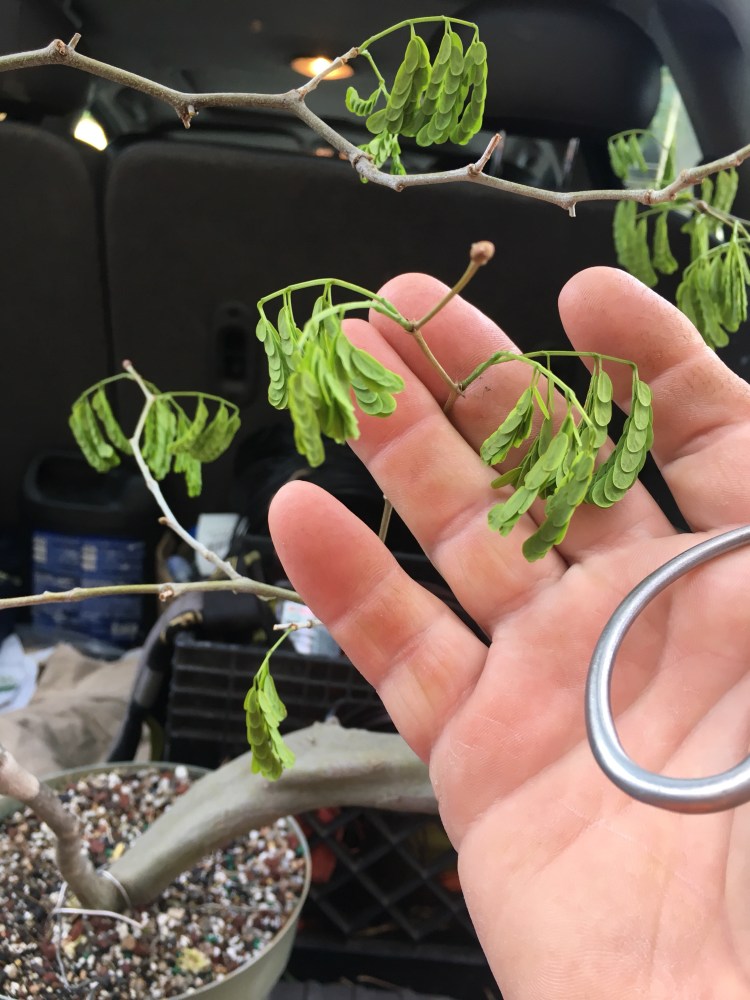 There have been many theories but it seems that it’s light sensitivity and a time factor that activate the opening/closing chemicals (and, as with many hormones, it’s the dominance of one over the other that causes the changes. In this case, the presence of the opening chemical, called a glucoside, is what keeps the leaf open, when light levels drop, there’s a catalytic reaction that degrades the chemical and causes the leaf close chemical (another type of glucoside) to increase, which causes the movement of potassium ions into a motor cell organ called the pulvinus, which occurs at the point where the leaf is attached to the stem. It’s all very complicated and happens at an alarmingly small molecular level (needing these thingies called “molecular probes”) and there’s all kinds of fancy words (motility, temporal, biotinylated, photosensitive etc) to read. Here’s a link to a study, if yer brave enough for it. Good reading for sure though.
There have been many theories but it seems that it’s light sensitivity and a time factor that activate the opening/closing chemicals (and, as with many hormones, it’s the dominance of one over the other that causes the changes. In this case, the presence of the opening chemical, called a glucoside, is what keeps the leaf open, when light levels drop, there’s a catalytic reaction that degrades the chemical and causes the leaf close chemical (another type of glucoside) to increase, which causes the movement of potassium ions into a motor cell organ called the pulvinus, which occurs at the point where the leaf is attached to the stem. It’s all very complicated and happens at an alarmingly small molecular level (needing these thingies called “molecular probes”) and there’s all kinds of fancy words (motility, temporal, biotinylated, photosensitive etc) to read. Here’s a link to a study, if yer brave enough for it. Good reading for sure though.

Anyway, all that and I just wantonly pluck the leaves as if I’m a giraffe nibbling on an Acacia tree on the African Savannah.
Defoliated.
 Or, denuded, if you were.
Or, denuded, if you were.
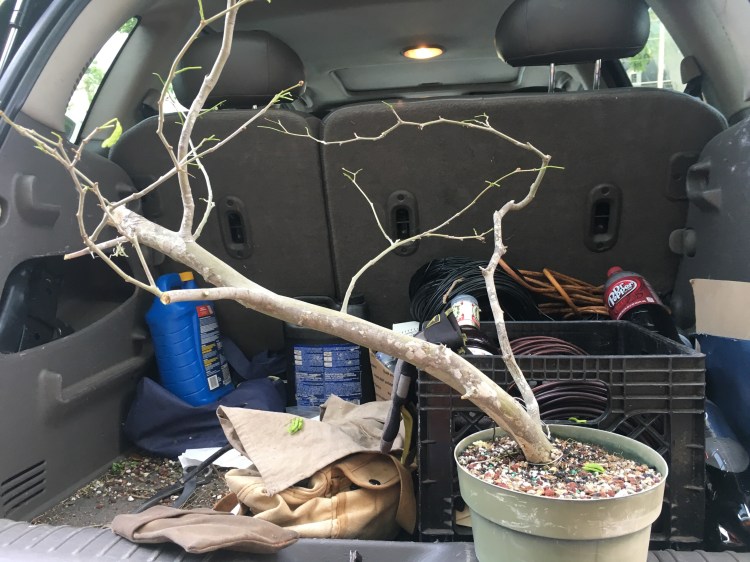
Now, before I begin wiring, I need to look at the roots. It’s a part of the health check I do before I begin heavy wiring and serious bending. The roots should be strong to make sure I’m not breaking them up when I’m man handling the plant. 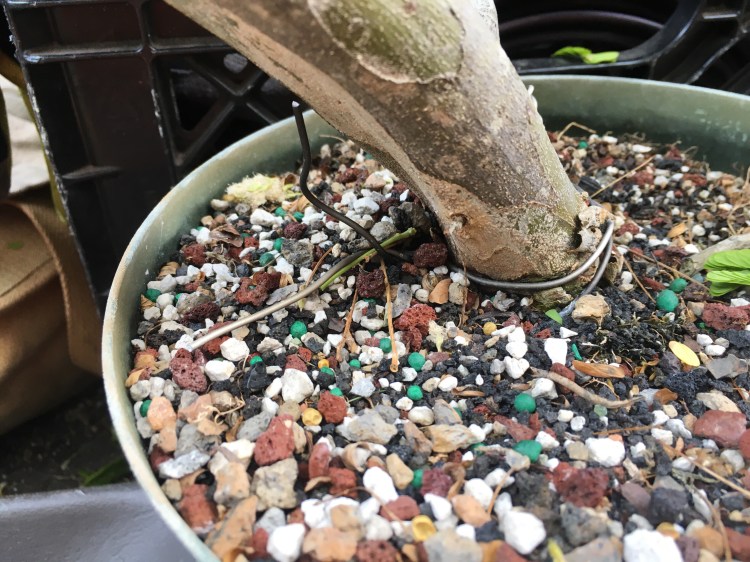
Like I said earlier, this tree was the result of an airlayer, off a tree planted by a bonsai enthusiast named Renee, from the Ft. Myers, Fl area.
It looks well rooted.

Not a fantastic nebari (root spread) yet but it’ll develop, with proper care every time it gets repotted.
 Those side roots will thicken and I’ll spread them out. That’s the advantage of tropical trees in general, you can get a nominal piece of material and in time, it turns into a good or great tree. But you should at least have some kind of interesting feature. Like this trees trunk.
Those side roots will thicken and I’ll spread them out. That’s the advantage of tropical trees in general, you can get a nominal piece of material and in time, it turns into a good or great tree. But you should at least have some kind of interesting feature. Like this trees trunk.
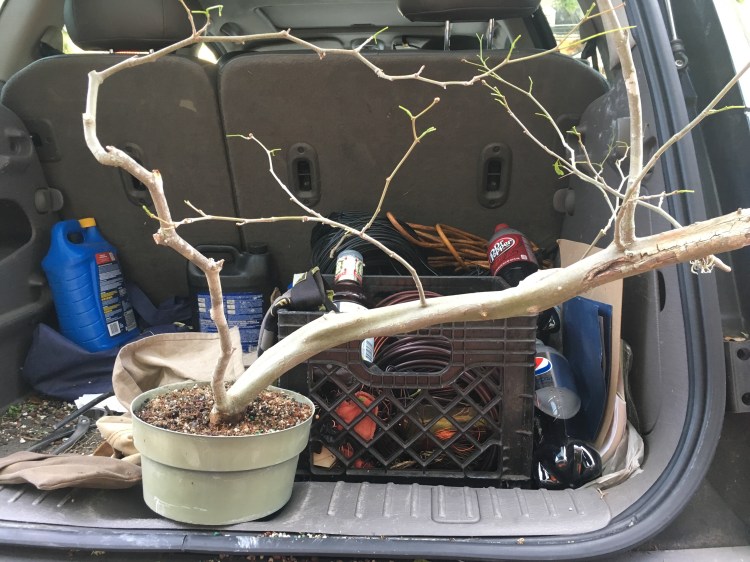
So then, essentially, above, we have the blank canvas.
Well, as much as that can apply to a plant.
We have a good back branch.

But a slight debit with this branch/trunk.

A straight “apex” with no taper.

And here is a design flaw with many different colorful terms, “the slingshot” or “the rams horn dilemma” or even “push me/pull me”.

I like to think of it in a different way. Now, don’t hold it against me but, I grew up in the “Grunge” era of rock n roll. And, as you may guess, one of the bands I listened to was Pearl Jam and they had a song called “Black”. There’s a line in there, the fourth or fifth, that describes this feature. You’ll have to look it up
Needless to say, this..,ah, splayed look isn’t demure enough for bonsai. Let’s try to teach some modesty to our raintree. We do that with bondage…..um, wiring.

Some wire here….to begin.
Before I continue with the bondage, I’ll wire all the heavy branches
And so, the “apex” is next.

I want to bring it way down and give it some movement. So I think three heavy wires…..

…..there we go. Now….

Some guy wires.
This is copper, it doesn’t stretch as badly as aluminum and is stronger at thinner gauges than aluminum, so I can hide it better.

We could use stainless steel or even galvanized baling wire but I ain’t got none right chere, so I’m using copper.
 I learned this method from Sergio Luciani. The wire goes around wire instead of the trunk, and……
I learned this method from Sergio Luciani. The wire goes around wire instead of the trunk, and……
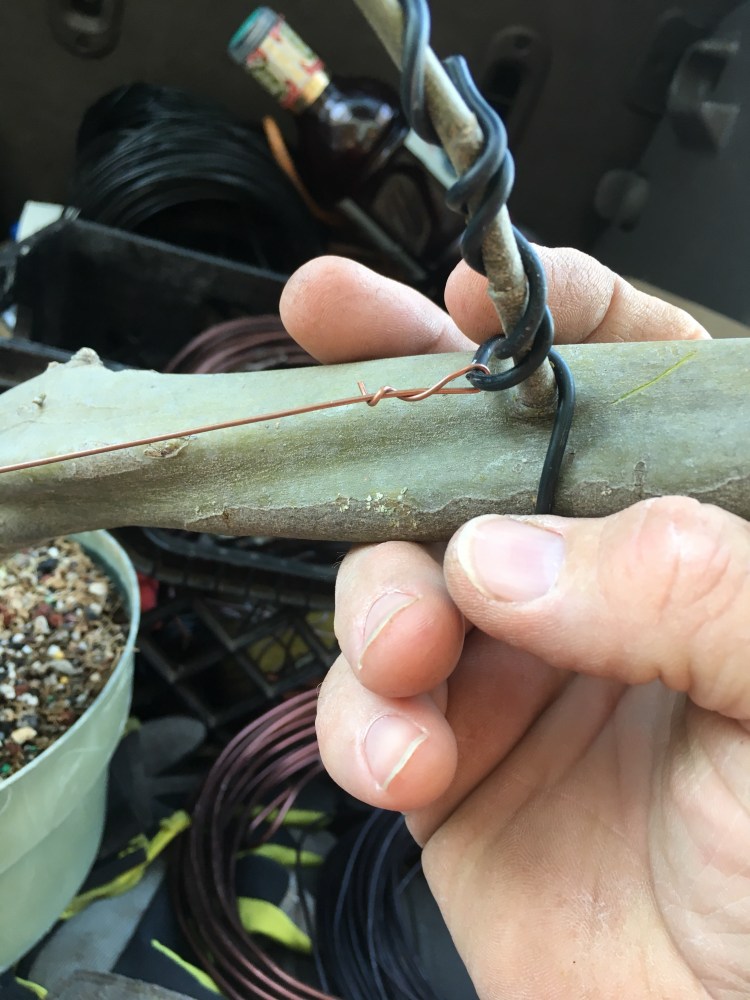 …..no twisting. You bend the trunk or branch past the point you need it to go (if you don’t flex it past, you’re not damaging the branch enough to get it to heal in the spot you want it to. It’ll just move back where it was before you tied it. Don’t believe me? Why, it’s a book fact..)
…..no twisting. You bend the trunk or branch past the point you need it to go (if you don’t flex it past, you’re not damaging the branch enough to get it to heal in the spot you want it to. It’ll just move back where it was before you tied it. Don’t believe me? Why, it’s a book fact..)

That will hold. And it’s not that visible.
Next, we bend. Let’s see if I can break it. I’m not sure I even want to incorporate it but I’m not ready to cut it yet.

That’s without the guy wire.
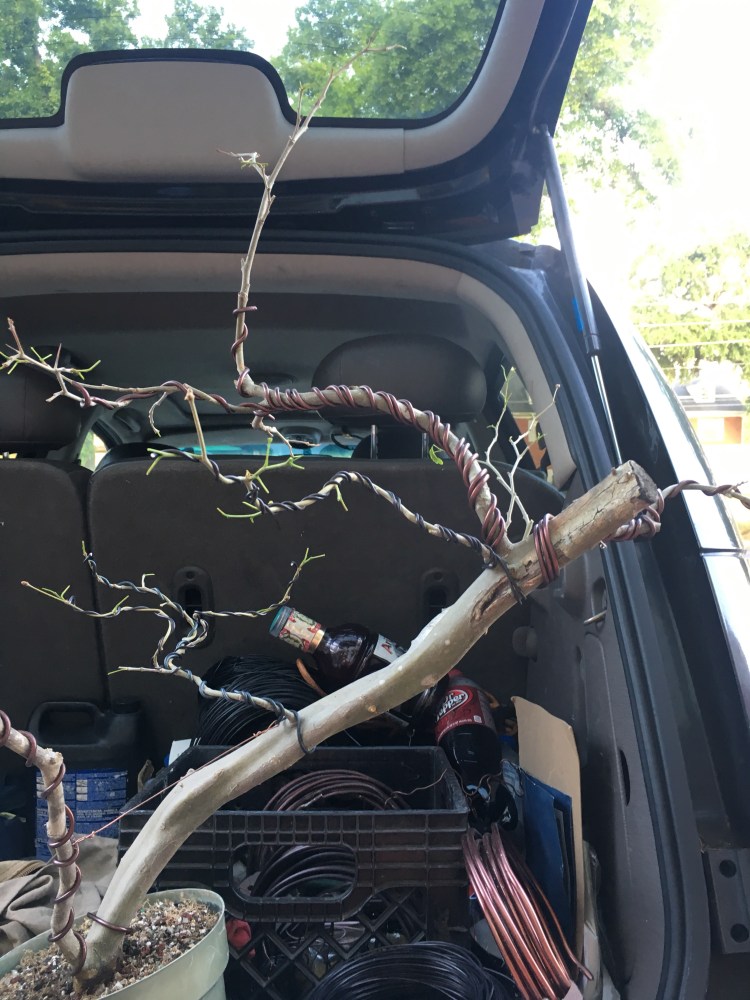
And with it…..
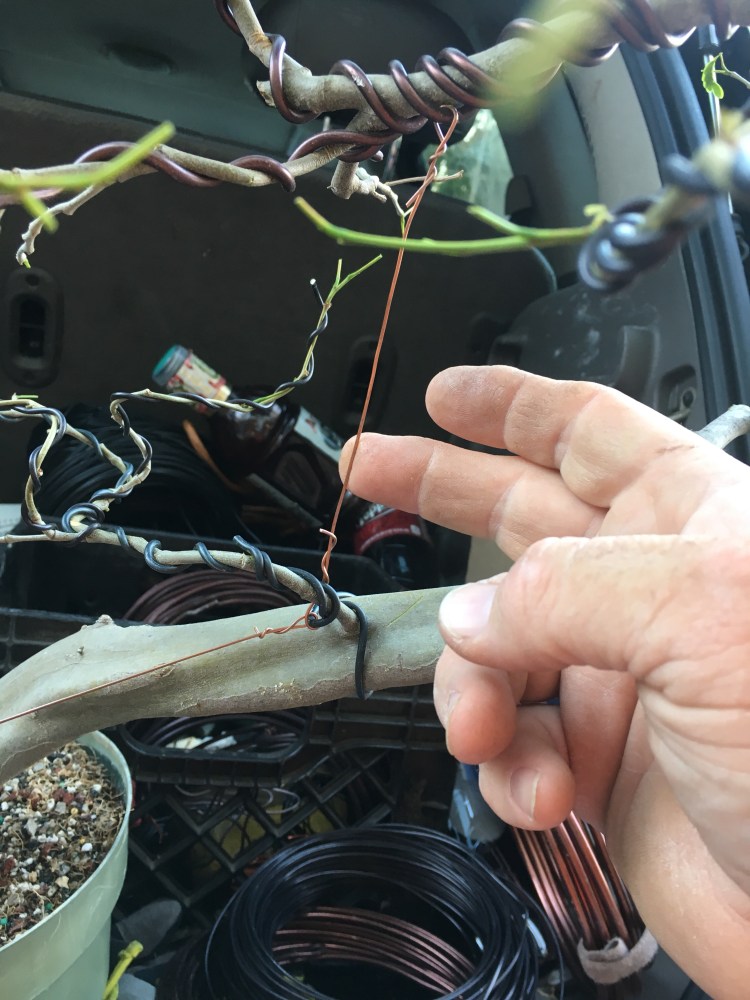
A good c-sharp note when plucked….

Now that I have the main branches moved, time for the secondary and thirdiary.
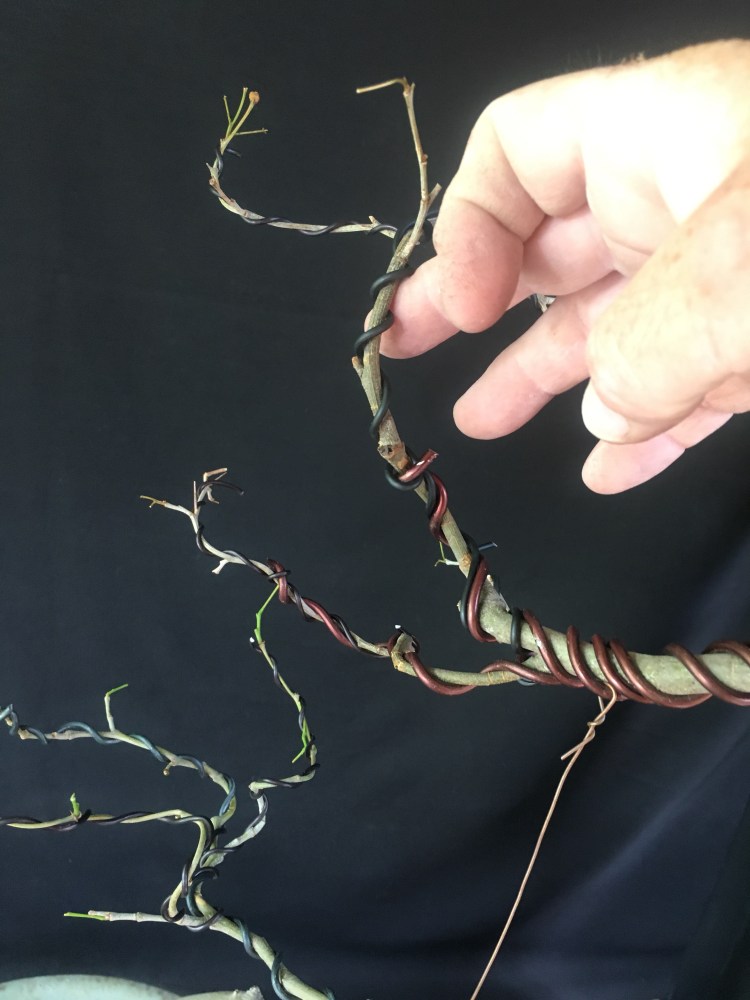
And I just would like to point out to the wire nazis out there (it’s a small N, I’m not calling you a real Nazi, don’t get your drawers in a bunch), the reason the wires on the “apex” are not perfectly touching and parallel is purely for support. When you bend a branch, it helps if you have a wire (or raffia or tape) supporting the outside of the bend; it’s less likely to break. So by spreading out the wire, you get better coverage and less breakage.
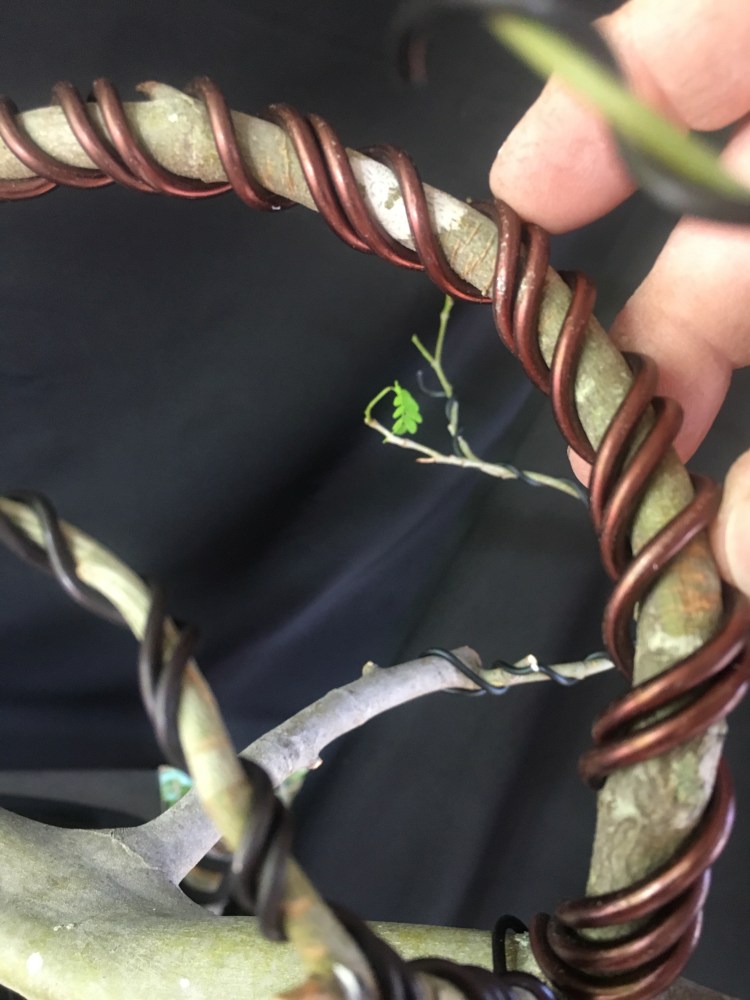
Oh, in case you missed it, I’ve moved back to The Nook. It’s easier to repot there than it is in a parking lot in the back of a PT Cruiser.
It’s also been about a week since I did the bending and the new buds have swelled even more. This is the combo flower/new leaf bud. They come out at the same time. Very interesting and different from a regular BRT.
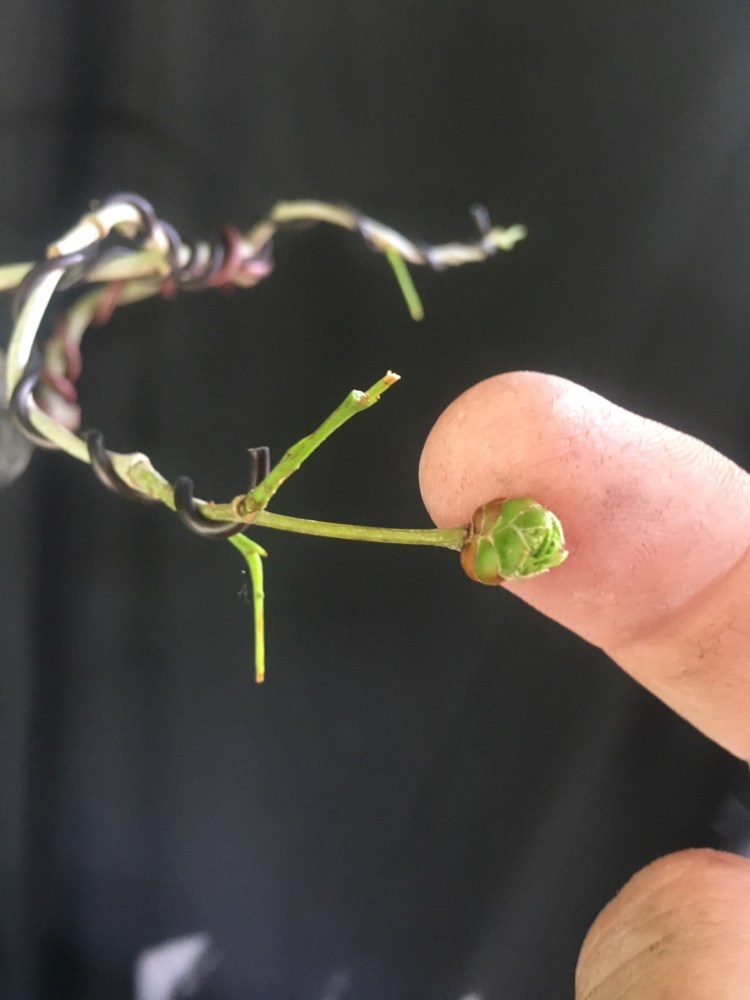
The cool pot I chose is a Dale Cochoy one from 2004.
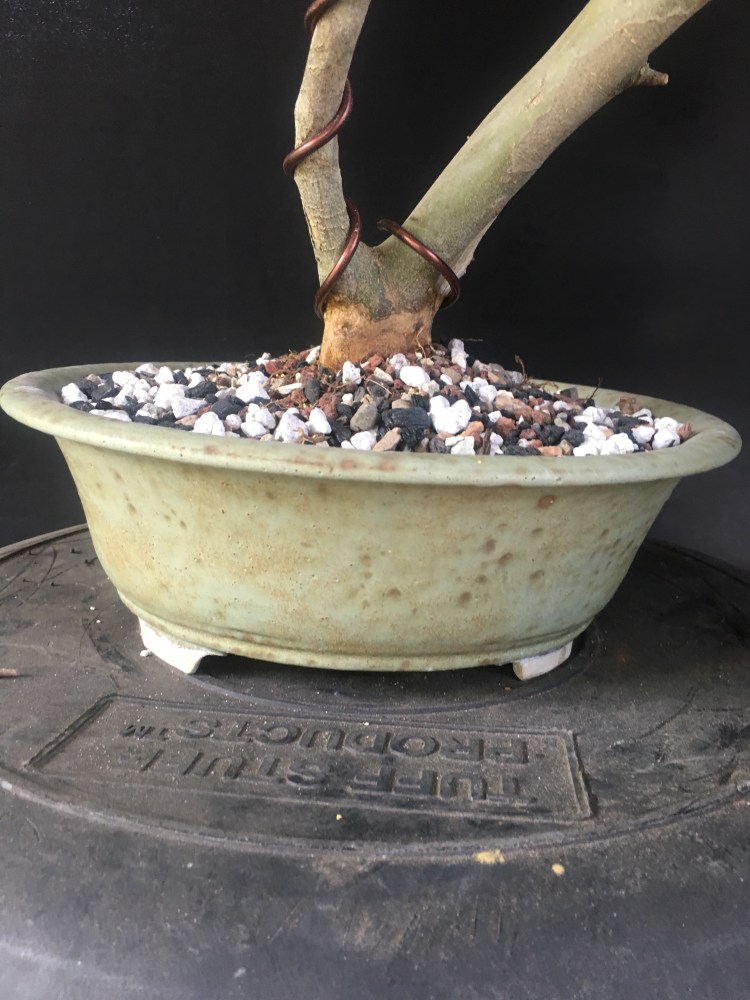
He’s one of the pioneers in American bonsai ceramics, up there with Sara Raynor.

Yakimono No Kokoro is the name of his studio I believe.
It fits the tree.
Now then my friends, you’re scratching your head a bit at the…uhh, lack of any traditional styling, aren’t you?
I mean, it’s not an informal upright, or a windswept or whatever.
 I’m calling it a Brazilian Raintree style. Not a flattop or a tropical broadleaf style. Just a BRT style. I’ve recently seen some pics of rain trees in the wild and, man are they wild. But I can’t post pics because of copyright laws and all that. Sorry.
I’m calling it a Brazilian Raintree style. Not a flattop or a tropical broadleaf style. Just a BRT style. I’ve recently seen some pics of rain trees in the wild and, man are they wild. But I can’t post pics because of copyright laws and all that. Sorry.
It’s ugly. Maybe even fugly. But I’ll post updates and you’ll see. It’ll be elegant and tree-like. Give it time. That’s the one thing we can’t give to tree, it just has to happen and we must be patient. They’ll be things that happen, branches that die or new branches that grow.
Time. That’s the best stylist we have.
P. S……..about those things happening…..
 There’s how I left it.
There’s how I left it.
A few days ago, my middle son knocked it off the bench and, in so doing, made that decision I was hesitating to do.

The pot didn’t break, he caught it before it could smash, but the damage was still done.
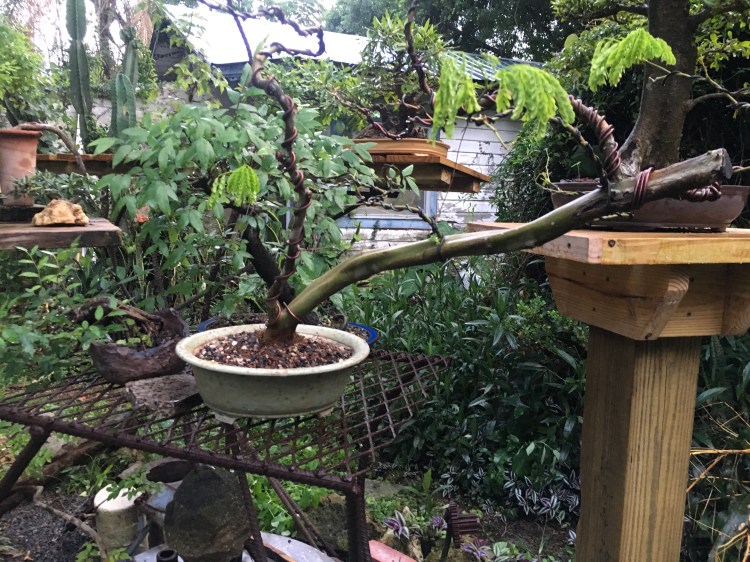
Broke the “apex”

It’s still alive at my fingertips…..
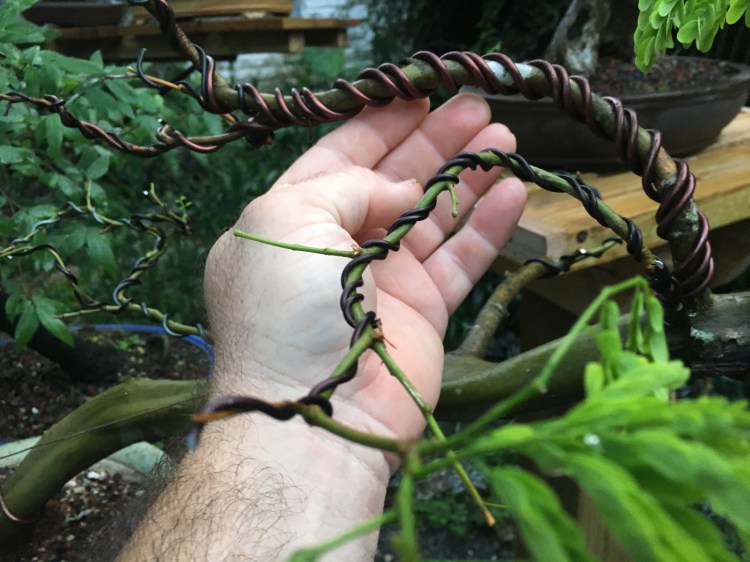
…as you can see by the green….

But the topmost branch is dead.
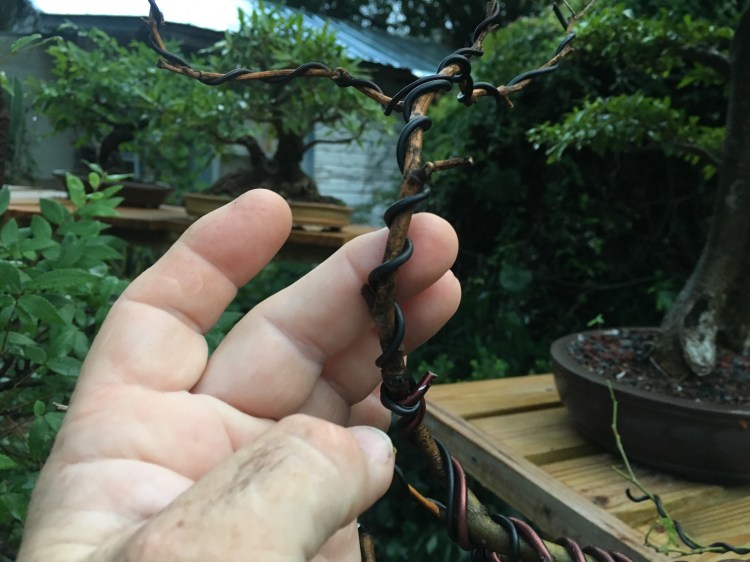
Broke a side branch.
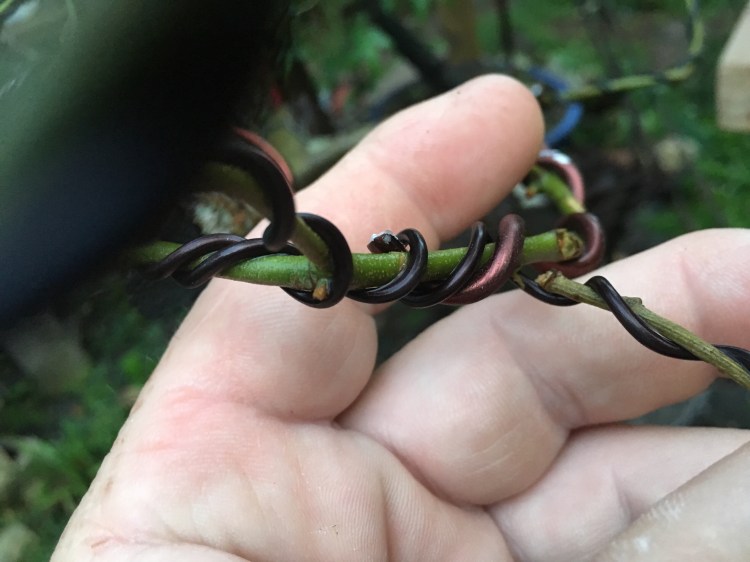
And another.

Time to chop.

Notice these aren’t my good concave cutters.
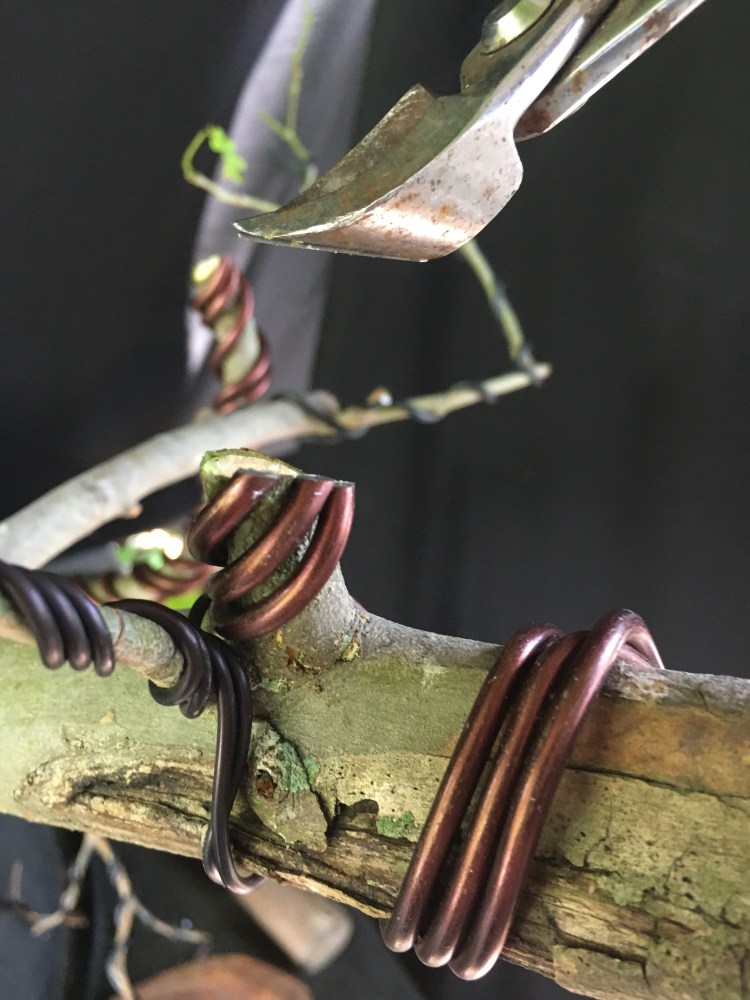
Orf wif ‘is ‘ead!

All that work…..it pains me.

It’ll be ok though. The boy is still alive too.
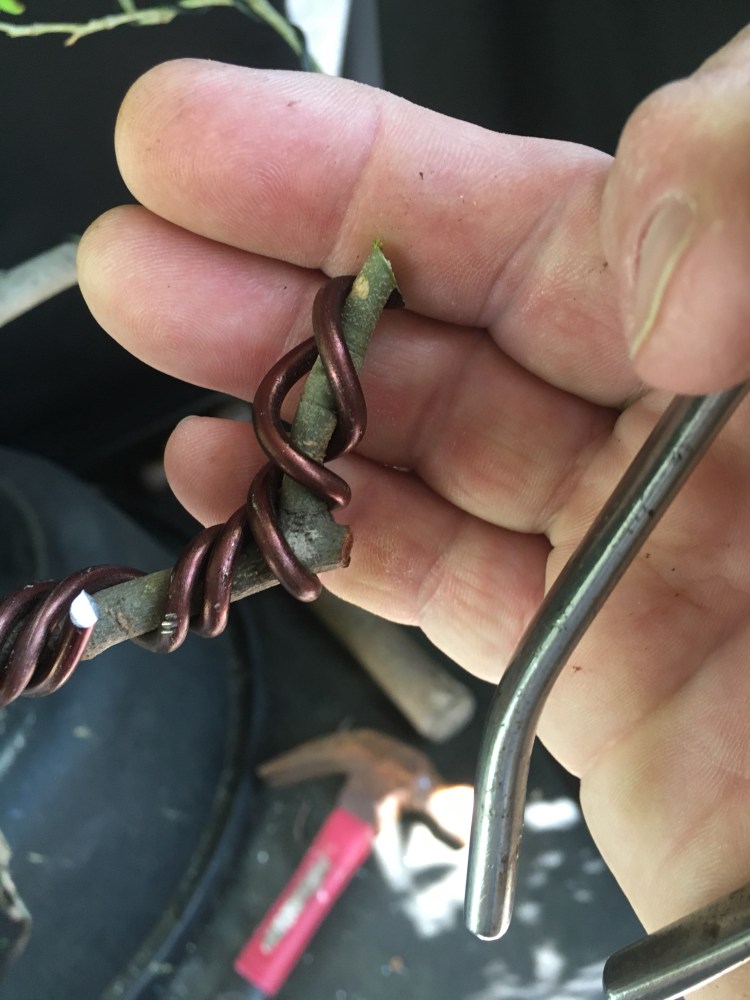
But…..damn it sets it back a bit.

Stay tuned, let’s see how it progresses now.
Reblogged this on Wolf's Birding and Bonsai Blog.
LikeLike
Thank you for the great post! – You mentioned seeing pictures of BRT in nature. As I am expanding my knowledge on Bonsai I find it difficult to find examples of trees (in nature) we are mimicking; either online or in books. Many articles/books focus on basics of Bonsai but never go into detail about the actual trees in nature. Any good book suggestions or online resources focused on the trees in nature that inspire the looks/styles of bonsai?
Many thanks for this wonderful blog!
LikeLike
A good book with great photos is Remarkable Trees of the World
by Thomas Pakenham
LikeLike
Looks like he has quite a few books on the subject. Perfect! Thanks again for your help!
LikeLike
The original styling looked like a harp!
LikeLike